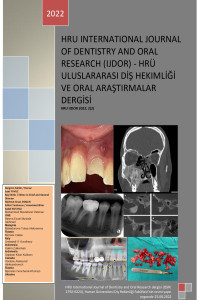EFFECT OF TURKISH DENTAL EDUCATION ON THE LEVEL OF KNOWLEDGE OF STUDENTS ABOUT EMERGENCY DENTAL APPLICATIONS
EFFECT OF TURKISH DENTAL EDUCATION ON THE LEVEL OF KNOWLEDGE OF STUDENTS ABOUT EMERGENCY DENTAL APPLICATIONS
Emergency Dental Applications, Covid-19, Pandemic,
___
- 1. Chen L, Liu W, Zhang Q, Xu K, Ye G, Wu W, et al. RNA based mNGS approach identifies a novel human coronavirus from two individual pneumonia cases in 2019 Wuhan outbreak.Emerg Microbes Infect.2020;9:313-9. https://doi.org/10.1080/22221751.2020.1725399
- 2. Phelan AL, Katz R, Gostin LO. The novel coronavirus originating in Wuhan, China: challenges for global health governance. JAMA. 2020;323:709-10. https://doi.org/10.1001/jama.2020.1097
- 3. World Health Organization – WHO. Rolling updates on coronavirus disease (COVID-10). 2020 May 11. Available from: https://www.who. int/emergencies/diseases/novel-coronavirus-2019/events-as-they-happen 4. American Dental Association – ADA. ADA.org: What Constitutes a Dental Emergency? (for Dentists) (libertydentalplan.com)
- 5. Zhong BL, Luo W, Li HM, Zhang QQ, Liu XG, Li WT, et al. Knowledge, attitudes, and practices towards COVID-19 among Chinese residents during the rapid rise period of the COVID-19 outbreak: a quick online cross-sectional survey. Int J Biol Sci. 2020;16:1745.
- 6. Harrel SK, Molinari J. Aerosols and splatter in dentistry: a brief review of the literature and infection control implications. J Am Dent Assoc. 2004;135:429-37. https://doi.org/10.14219/jada.archive.2004.0207
- 7. Duruk G, Gumusboga ZS, and Colak C. Investigation of Turkish dentists’ clinical attitudes and behaviors towards the COVID-19 pandemic: a survey study. Braz oral res [online]. 2020;34:e054.https://doi.org/10.1590/1807-3107bor-2020. vol34. 0054.
- 8. Taber KS. The use of Cronbach’s alpha when developing and reporting research instruments in science education. Research in Science Education; 2018;48:1273-96.
- 9. Carrouel F, Gonçalves LS, Conte MP, Campus G, Fisher J, Fraticelli L, et al. Antiviral Activity of Reagents in Mouth Rinses against SARS-CoV-2. J Dent Res. 2020; 0022034520967933. https://doi.org/10.1177/0022034520967933
- 10. Aras A, Akyol S, And Yildiz S. Evaluation of the Knowledge Levels of the Turkish Population on Emergency Dentistry Practices Determined After the COVID-19 Outbreak. Journal of Harran University Medical Faculty. 2020;17:360-5
- Başlangıç: 2021
- Yayıncı: Harran Üniversitesi
DİŞ SÜRMESİNDE D VİTAMİNİNİN ROLÜ; DERLEME
Meryem ŞAHİN, İsmet Rezani TOPTANCI
Tolga Han EDEBAL, Sedef KOTANLI, Halil İbrahim DURMUŞ
ÇOCUK DİŞ HEKİMLİĞİNDE PROBİYOTİKLER
FIBROUS DYSPLASIA : A CASE REPORT
Halil İbrahim DURMUŞ, Saliha Zeynep AÇAR
Treatment of young permanent teeth pulpitis with formocresol pulpotomy
CA(OH)2 APEXIFICATION TO A TOOTH WITH CHRONIC APICAL ABSCESS: A CASE REPORT
DOĞU ANADOLU BÖLGESiNDEKi TÜRK ÇOCUKLARINDA DiL ANOMALiLERiNiN YAYGINLIĞI
Sacide DUMAN, Pelin Senem ÖZSUNKAR
REMOVAL OF A BROKEN PATHFILE: CASE REPORT
Faruk ÖZTEKİN, Tuba TALO YILDIRIM, Osman ATAŞ, Melek Didem TOZUM
